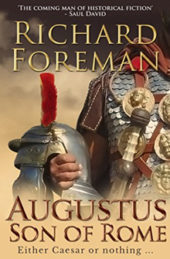Can you tell us a bit about the plot of Turpin’s Rival? Even more than Turpin’s Assassin, the novel reads like a revenge thriller.
Having established Turpin in the first book, I wanted to up the pace and violence for the sequel. Turpin is as much an anti-hero as hero. It’s a story of revenge and rivalry. The villain of the piece, the highwayman James Skinner, is similar yet different to Turpin. In some ways the reader and Turpin are sympathetic to Skinner’s cause of bettering the treatment of soldiers, but his character and manner of achieving his aims are less endearing. I was also keen to have Turpin travel to London again and include Joseph Colman in the plot – and have the outlaw interact with Samuel Johnson once more.
As well as being violent in places, Turpin’s Rival also contains plenty of humour. Is the juxtaposition of such scenes and lines deliberate?
In a word, yes. I feel pretty comfortable placing such scenes together. As to whether they work or not I will let the reader decide. The English are of course known, both now and in the 18th century, for their sense of humour and propensity for violence. They are also known for their love of alcohol too, which can generate both humour and belligerence.
I also think that the style and structure of the Turpin novels stems from reading plenty of Bernard Cornwell and George Macdonald Fraser books over the years. Like England in the 18th century, I want these novels to be fun.
Having written various series set in Ancient Rome and Medieval Europe, how are you finding England in the 18th century? There are plenty of nuggets of information in the novel, about the culture of coffeeshops and the literary world in the Georgian period for instance. Are you enjoying the research?
It’s a far more welcome place to be, despite or because of all the crime and alcohol. Although they are not wholly the same of course, one can recognise certain similarities between 18th century London and the capital today. The city was an engine of commerce and burgeoning culture, fuelled by gin, coffee and sugar. There was a monied elite and the newspapers were not known for always reporting the truth. It was a time of relative peace and prosperity (they two, in some ways, are related). I wish I could spend more time researching the period, both the criminal and upper classes (the two, in some ways, are related as well). I also wish I had more time to re-read the likes of Swift, Dr Johnson and Alexander Pope, for both pleasure and research purposes.
How much is your Dick Turpin based upon the real highwayman?
The first book addressed several facts and incidents in Turpin’s life which are on the historical record, but the protagonist in this series should be treated more like a character in a novel. There is Turpin the man and Turpin the legend. I have attempted to marry both up, but people should read Turpin’s Rival in the knowledge that it is a work of fiction. However, should you be interested in the history of the period and the “real” Dick Turpin, the series should still entertain and engage the reader (I hope). The end notes in the novel also recommends some further reading.
What are you working on at the moment? Are you planning to write another Turpin novel?
Yes, I am currently writing Turpin’s Prize. I can’t say too much at the moment, except to say novel will feature William Hogarth – and a heist. The aim is to publish by the end of July, but we’ll see. It depends on how much gin, coffee and sugar I have between now and then.
Richard Foreman’s Turpin’s Rival is out now.







